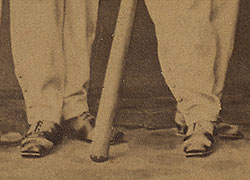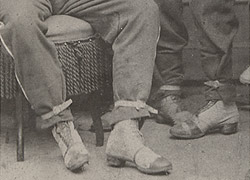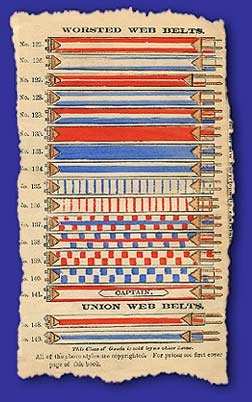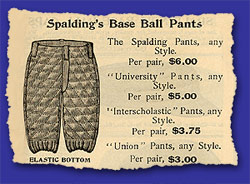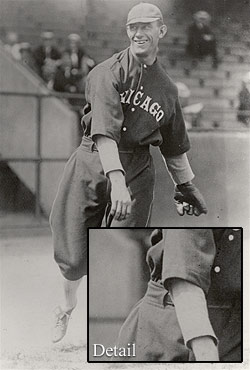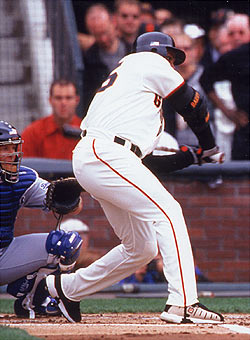 |
|
|
Pants
|
|
|
Baseball pants are an often ignored part of the baseball uniform. Unlike the cap and jersey, pants are not marketed to the baseball fan as a retail product. Yet, pant styles attract a significant amount of attention from ballplayers and fans alike. The size and length of pants as donned by big leaguers vary more today than ever before. It remains to be seen if new regulations regarding baseball pants curb some of the extremes in pant fashions.
|
|
|
|
Troubles with TrousersThe first official baseball uniform, those worn by the Knickerbocker Base Ball Club of New York City in the late 1840s, included blue wool pants or, as they were called at the time, “pantaloons.” Though full-length trousers remained in vogue through the 1860s, many baseball clubs, in an effort to eliminate discomfort and improve mobility, experimented with their pants. In order to keep pant legs from catching on shoes or otherwise interfering with a player’s actions, some clubs adopted pants with buttons on the sides of the leg openings, resulting in a tight-fitting, tapered fit at the shoe top. Other clubs belted the leg openings in order to keep them from interfering with play. It was not until 1867 that a club decided to solve the problem of loose leg openings by simply eliminating the bottoms of the pants altogether by donning knickers. The first club to adopt knickers as a part of their baseball uniform was the 1867 Cincinnati Red Stockings, who borrowed the idea from cricket. The knee-high pants proved both comfortable and convenient, while also managing to show off another feature of Cincinnati’s uniform: their red stockings. At
top left: Button-bottomed pant legs of the New York Mutuals, 1864
|
|
|
About BeltsThough a belt’s practical purpose is to secure the pants to the waist, early baseball belts were also used for decoration. Wide belts of the 1850s and ’60s were generally made of leather, enamel-coated leather or wool, and were often adorned with team names or colorful patterns. Though such wild belt styles were sold throughout much of the 19th century, by the 1870s the styles and color schemes of belts as worn in the big leagues were quite conservative. Indeed, by the last decade of the century, the belt had become a mere afterthought of the baseball uniform. With rare exception (the 1926 Cardinals, for instance, donned red belts), solid brown, black and dark blue belts were the dominant styles of the first half of the 20th century. The first modern-day departure from this drab color scheme came when the redesigned Phillies uniform of 1950 introduced a bright red belt. The Cincinnati Reds and St. Louis Cardinals, the clubs most understandably associated with red, soon adopted similarly colored belts. The brightly colored Kansas City Athletics uniform of 1963 featured green belts, and by the end of the 1960s nearly half of all big league clubs were wearing colored belts. At left: An advertisement for baseball belts as found in DeWitt’s Base Ball Guide of 1876
|
Without BeltsWhen the 1970 Pittsburgh Pirates moved into their new ballpark, Three Rivers Stadium, in mid-season of 1970, they unveiled the first-ever beltless pants with an elastic waistband to keep the pants snugly in place. The beltless look was eventually adopted by nearly every major league team, with only five clubs of the era (the Dodgers, Expos, Mets, Yankees, and Phillies) choosing to shun the style. The beltless era “officially” ended in 1993, when the Reds became the last club to return to the more conservative style uniform.
|
|
|
|
Adding PaddingThe rough-and-tumble style of play that came into vogue during the 1880s resulted in more wear-and-tear on the baseball player’s body. It is not surprising that due to the aggressive base running of the era, quilted padding was incorporated into uniform pants. The all-in-one padded pants remained popular for a few decades, but separate padding specifically worn under the pants eventually took over as the preferred means of protection. At left: An advertisement for padded pants as found in Spalding’s Official Base Ball Guide of 1903
|
|
|
Tunnel VisionIn a game between Indianapolis and Boston in 1887, Boston outfielder King Kelly found himself on third base when a fly ball was hit deep enough for him to tag up after the catch. As Kelly tried to leave third base, however, he found that he was unable to budge. Turning around, Kelly saw that Indianapolis third baseman Jerry Denny had grabbed Kelly’s belt in order to slow him down. Denny let go before the umpire could notice the illegal tactic, and the ploy saved a run. Some versions of the tale continue with a later incident in which Kelly was once again on third in a similar situation, but this time when Denny attempted to slow him down, the third baseman found himself with nothing but a belt in his hand. It seems Kelly had simply unhitched his belt before tagging up. Though these stories are most likely apocryphal, it does point out a flaw in the baseball uniform. The addition of a second umpire did much to end this kind of trickery, but another solution would have been the introduction of material around the waist that covered otherwise exposed lengths of the belt. It was not until the 1910s, however, that the innovative belt tunnels were added to the baseball uniform. By the 1920s, belt tunnels were used by nearly every major league club, and they remain in use today. At left: Chicago White Sox outfielder Shano Collins wearing early belt tunnel, c. 1913
|
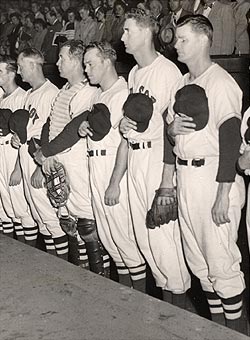
|
The Pants DanceThroughout the 19th century and the first few decades of the 20th century, ballplayers wore their pants so that their stockings showed to the bottom of their knee. But a trend toward lowering the pant leg crept into baseball fashion. One of the earliest ballplayers to adopt the so-called “low-roll”-style trousers was New York Giants pitcher Carl Hubbell. Later, Ted Williams adopted the style. These high-profile players popularized the trend and soon ballplayers throughout organized baseball were lowering their pant legs. Unexpected problems arose as a result of the fad. In the early 1950s, longtime umpire Bill Stewart called for an end to the long pants, citing difficulties in determining the location of a batter’s knee, and thus the bottom of the strikezone. Stewart’s complaints did little to halt the pants-lowering trend. By the 1950s, most players wore their pants nearly halfway between their knees and shoe tops. Meanwhile, uniform pants were also becoming less baggy, and by the 1970s most players wore tight-fitting pants. The 1980s saw the first experimentation with the extremely low pant leg, as players such as St. Louis Cardinals outfielder George Hendrick began to adopt the radical style. During the decade of the 1990s, the height of the pant leg dropped precipitously, with some players even tucking the pant legs into their shoes. Modern stars such as Barry Bonds, Manny Ramirez and Cliff Floyd have adopted the “no-sock” look, employing special attachments to the bottoms of their pants to ensure that they remain in place. And many of today’s players have shunned the tight-fit look in favor of baggier pants. The 2002-2006 Collective Bargaining Agreement (CBA) is the first to include a section on uniform regulations. The CBA has no fewer than seven regulations regarding pants, limiting the pant length to be no lower than the top of the shoe heel and discouraging the baggy-pants look. At top left: Ted Williams (second from right) wearing his
pants noticeably lower than his Boston Red Sox teammates, 1948
|
|
Dressed to the Nines: A History of the Baseball Uniform |
|
